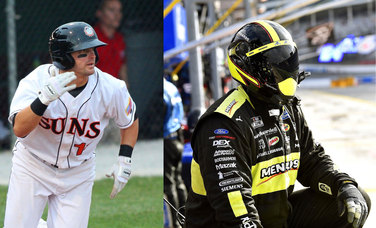Athletes Help Team Penske on NASCAR Pit Lane
October 13, 2020
"Penske Material" provides an inside look at some of the personalities, stories and moments that make Team Penske so unique.
The term “misconception” gets used a lot, but what does it really mean? What is the literal definition of the word? According to Merriam-Webster, the definition of misconception is “a wrong or inaccurate idea.”
For many years there was a misconception that NASCAR was not a team sport.  The term “team sport” was traditionally reserved for stick-and-ball sports like baseball, basketball, football and hockey. Even as the Wood Brothers began to revolutionize the modern-day pit stop in NASCAR during the 1960s to place a greater emphasis on the pit crews, people mostly still focused on the drivers holding the wheels of the muscular American beasts as the sport began to gain popularity throughout the nation.
The term “team sport” was traditionally reserved for stick-and-ball sports like baseball, basketball, football and hockey. Even as the Wood Brothers began to revolutionize the modern-day pit stop in NASCAR during the 1960s to place a greater emphasis on the pit crews, people mostly still focused on the drivers holding the wheels of the muscular American beasts as the sport began to gain popularity throughout the nation.
Gradually, however, time spent on pit road began to factor into race-winning strategies. At some of the most challenging racetracks – crew chiefs have been known to say – it is easier to pass cars on pit road than it is on the track.
Now, that original misconception has been cast to the side like second-day qualifying. NASCAR racing is undoubtedly viewed as a team sport. Championships and races can be won or lost on pit road, just the same as they can be on the racetrack. And because the pit lane pendulum can swing swiftly, teams have placed an even greater importance on finding finely-tuned athletes that can pit a car for four tires and fuel in under 12 seconds.
Today, Team Penske Director of Athletics Jim Beichner and NASCAR Pit Crew Coach Trent Cherry are tasked with attracting, developing and maintaining a roster of 25-30 individuals that can perform those tasks, many of whom are former professional and college athletes. Both Beichner and Cherry know what elite athletes look like and whether they can transition to the high-pressure environment that is a NASCAR pit road.
In 2013, Beichner, a former All-American wrestler and contender for the 1988 Olympic team, carried his experience from 18 years as head coach of the University of Buffalo wrestling program into a job that called for similar traits that he used on the mat. The same goes for Cherry, who was an NCAA Division II quarterback at Lenoir-Rhyne University before be became a tire carrier in 2000, the same year he became a pit crew coach.

 So, what is the key to taking athletes in traditional sports and helping them transition to perform a skill that many have never attempted? Not surprisingly, Cherry said he believes a good place to start is the gridiron.
So, what is the key to taking athletes in traditional sports and helping them transition to perform a skill that many have never attempted? Not surprisingly, Cherry said he believes a good place to start is the gridiron.
“I believe that football players are the best overall athletes,” says Cherry. “Defensive ends and linebackers make great jackmen, and defensive backs have transitioned very well to the role of tire changers. But we also have great pit crew members that came from baseball, basketball, wrestling, and track and field backgrounds.”
While overall strength and conditioning is important – tire assemblies weigh 70 lbs. with full cans of fuel weighing 90 lbs. – Cherry also looks for another, important quality that many former athletes typically possess.
“Aside from physical size and how that applies to our sport, I also look to see how fast they can process information,” continued Cherry. “Football players have to process a lot of information in a short amount of time. Pit road is exactly the same.”
 With the increase in the number of athletes that have joined pit crews in the last decade, the pool of potential candidates is bigger than ever. Yet, Beichner and Cherry still draw on contacts from other sports to mine the country for the right fit at Team Penske. Once athletes join the program, it is still a long road before they see action in a NASCAR Cup Series race.
With the increase in the number of athletes that have joined pit crews in the last decade, the pool of potential candidates is bigger than ever. Yet, Beichner and Cherry still draw on contacts from other sports to mine the country for the right fit at Team Penske. Once athletes join the program, it is still a long road before they see action in a NASCAR Cup Series race.
“Once we start working with them in our program it can be anywhere from two to four years before they see live action with one of our Cup teams,” says Cherry. “We do provide pit crew talent to some other teams and that helps accelerate the process. It’s hard to simulate a live pit road in practice.”
There are more eyes and attention focused on pit road than ever before, and with it comes the increased pressure to perform. This kind of pressure is nothing new to elite-level athletes in other sports and that can also help with the transition to racing.
“Think about how many plays are run in a football or basketball game,” said Beichner. “These guys only have small number of opportunities (five to 15) to perform per race and each one is crucial. That is a pressure-packed environment.”
Current Team Penske Pit Crew Members Who Are Former College Athletes
Chris Conklin – Jackman, No. 12 Ford Mustang/NCAA Division II All-American Tight End at Wingate University and Carolina Panthers practice squad
Wade Moore – Tire Carrier, No. 12 Ford Mustang/ N.C. State University Outfielder who spent time in the Washington Nationals system
Pat Gray – Jackman, No. 2 Ford Mustang/Wide Receiver at Monmouth University
Nathan Ricketts – Jackman, No. 21 Ford Mustang/Central Michigan University Linebacker
Blake Baker – Gasman, No. 21 Ford Mustang/NCAA Division II All-American Defensive End
Graham Stoddard – Jackman, No. 12 Ford Mustang/University of Nebraska Linebacker
Nick Hensley – Gasman, No. 22 Ford Mustang/Kings College Pitcher
Andy Lackey – Gasman, No. 2 Ford Mustang/UNC-Pembroke Offensive Lineman
More Penske Material
Read more about the personalities, stories and moments that make Team Penske unique.



